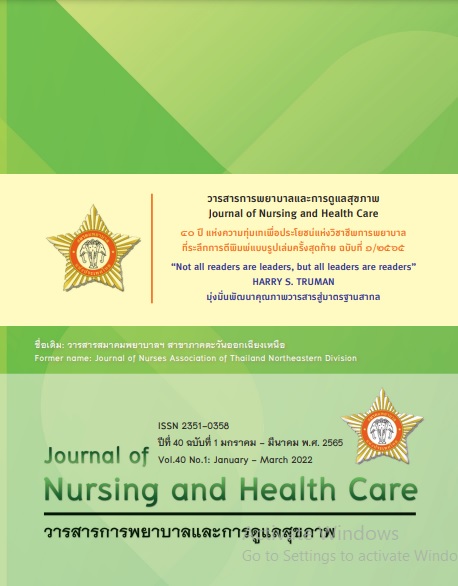การพยาบาลผู้ป่วยโรคติดเชื้อโคโรนาไวรัส 2019 ที่มีภาวะหายใจลำบากเฉียบพลัน
คำสำคัญ:
: โคโรนาไวรัส -19, การพยาบาลผู้ป่วยโรคติดเชื้อโคโรนาไวรัส -19,การพยาบาลบทคัดย่อ
โรคติดเชื้อโคโรนาไวรัส -19 เป็นโรคอุบัติใหม่ร้ายแรงที่กำลังแพร่ระบาดไปทั่วโลกรวมทั้งในประเทศไทย โรคนี้เกิดจากเชื้อ Severe Acute Respiratory Syndrome Coronavirus 2 (SARS-CoV-2) สามารถติดต่อผ่านระบบทางเดินหายใจ จึงทำให้เชื้อโรคแพร่ระบาดได้อย่างรวดเร็วทำให้มีผู้ป่วยและผู้เสียชีวิตจำนวนมากและยังคงเพิ่มขึ้นอย่างต่อเนื่อง บางรายมีอาการเล็กน้อยถึงปานกลางบางรายมีอาการรุนแรงมากถึงขั้นเสียชีวิตได้ โดยในกลุ่มที่มีอาการรุนแรงมักพบพยาธิสภาพที่ปอด ทำให้ร่างกายมีการแลกเปลี่ยนออกซิเจนลดลงจนเกิดภาวะพร่องออกซิเจน (Hypoxia) ภาวะหายใจลำบากเฉียบพลัน (Acute respiratory distress syndrome) และอวัยวะต่างๆ ทำงานล้มเหลว (Multi organ failure) ตามมา ซึ่งนำไปสู่การเสียชีวิตได้ ดังนั้นพยาบาลจึงจำเป็นต้องมีความรู้ความเข้าใจเกี่ยวกับโรค แนวทางการรักษาและการพยาบาลผู้ป่วย เพื่อใช้เป็นแนวทางในการปฏิบัติการพยาบาลให้มีประสิทธิภาพ ซึ่งบทความนี้มีวัตถุประสงค์เพื่อทบทวนวรรณกรรมเกี่ยวกับพยาธิสภาพของโรค แนวทางการรักษาและการพยาบาลผู้ป่วยโควิด-19 ที่ได้รับการบำบัดด้วยออกซิเจนอัตราไหลสูง การใช้เครื่องช่วยหายใจและการจัดท่านอนคว่ำ เพื่อลดโอกาสการเกิดภาวะแทรกซ้อนที่รุนแรงจากพยาธิสภาพของโรคและลดอัตราการเสียชีวิตของผู้ป่วยต่อไป
Downloads
เอกสารอ้างอิง
World health organization. WHO-convened Global Study of Origins of SARS-CoV-2; China Part [Internet]. 2021 [Cited 2021 SEP 7]. Available from: file:///C:/Users/Admin/Downloads/Final-joint-report_origins-studies-6-April-201%20(2).pdf
World health organization. Coronaviruses diseases (COVID-19) [Internet]. 2021 [Cited 2021 SEP 7]. Available from: https://www.who.int/health-topics/coronavirus#tab=tab_1.
Ministry of public health; Department of medical service. Medical practice guidelines for diagnosis treatment and infections control in hospital; for coronavirus 2019 approve version 21 July 2021 [Internet].2021 [Cited 2021 SEP 7]. Available from: https://covid19.dms.go.th/backend/Content/Content_File/Covid_Health/Attach/25640721115923AM_CPG_COVID_v.16.4.n.pdf
World health organization. WHO Coronaviruses (COVID-19) Dashboard [Internet].2021 [Cited 2021 Dec 3]. Available from: https://covid19.who.int/.
Open Development Thailand. Coronavirus disease 2019 outbreak in Thailand [Internet].2021 [Cited 2021 SEP 7]. Available from: https://thailand.opendevelopmentmekong.net/th/topics/pandemics-covid-19/.
Ministry of public health. Situation report for coronavirus disease 2019 [Internet].2021[Cited 2021 DEC 3].Available from: https://ddc.moph.go.th/covid19-dashboard/
Centers for disease control and prevention. Coronavirus disease 2019 (COVID-19) [Internet]. 2021[Cited 2021 Mar 25].Available from:https://www.cdc.gov/coronavirus/2019-ncov/symptoms-testing/symptoms.html
Coperchinia F, Chiovatoa L, Croce L, Magri F, Rotondi M. The cytokine storm in COVID-19:
An overview of the involvement of the chemokine/chemokine receptor system. Cytokine and Growth Factor Review [Internet]. 2020 [Cited 2021 Sep 19]; 53:25-32. Available from: https://doi.org/10.1016/j.cytogfr.2020.05.003
Centers for disease control and prevention. Assessing risk factors for severe COVID-19 Illness [Internet].2021[Cited 2021 Sep 19].Available from: https://www.cdc.gov/coronavirus/2019-ncov/covid-data/investigations-discovery/assessing-risk-factors.html
Ministry of public health. Practice guidelines for diagnosis treatment and prevention coronavirus disease 2019 in hospital [Internet].2021 [Cited 2021 Sep 19]. Available from: https://covid19.dms.go.th/backend/Content/Content_FIle/Bandner_(Big)/Attach/25650304082817AM_CPG_COVID-19_v.20.4_N_20220301.pdf
Joshi S, Parkar J, Ansari A, Vora A, Talwar D, Tiwaskar M et al. Role of favipiravir in the treatment of COVID-19. International journal of infectious diseases 2021; 102(1): 501-8.
Chienko W, Marcrolain J, yaolee N, Linchen P, Taihuang C, Inglee P, Renhsues P. Argument in favour of remdesivir for treating SARS-CoV2 infection. International journal of antimicrobial agents 2020; 55(4): 105933.
Beigel J, Tomashek K, Dodd L, Mehta A, Zingman B, Kalil A et al. Remdesivir for the treatment of Covid-19. The New England Journal of Medicine 2020; 383(16):1813-26.
Raoof S, Nava S, Carpati C, Hill N. High - Flow, Non-invasive ventilation and awake (non-intubation) proning in Covid-19 patients with respiratory failure. Science Direct; CHEST 2020; 158(5):1992-2002.
Maria V, Roberto D, Gustavo O, Nicolas C, Mauro C, Lara P et al. COVID-19 Pneumonia and ROX index; Time to set a new threshold for patients admitted outside the ICU.Pulmonology 2022; 28(1): 13-7.
Frat J, Thille A, Mercat A, Girault C, Ragot S, Perbet S et al. High-flow oxygen through nasal cannula in acute hypoxemic respiratory failure. New English Journal Medicine 2015; 372(23): 2185-96.
Thanakijtummakul N. Nursing Care for Covid-19 Patients with Acute Respiratory Distress Syndrome. Journal of Thailand Nursing and Midwifery Council 2564; 36(3): 16-30.
Watcharanat P, Namvongprom A, Pakdevong N. The effectiveness of nursing care protocol on ventilator associated - pneumonia in patients with mechanical ventilator. Kuakarun Journal of Nursing 2015; 22(1): 144-55.
Niamwan C, Reangsan D, Kankarn W. The professional nurses’ competencies in nursing patients
using mechanical ventilation. Journal of nursing and health care 2020; 38(1): 6-14.
Stonecypher K. Ventilator associated pneumonia: The important of oral care in intubated adults. Critical Care Nurse 2010; 33(4): 339-47.
Stephan E, Jie L, Miguel I, Yonatan P, Ivan P, Bairbre M, et al. Awake prone positioning for COVID-19 acute hypoxemic respiratory failure: a randomised, controlled, multinational, open-label meta-trial. Lancet Respiratory Medication 2021; 9(12): 1387-95.
Venus K, Munshi L, Fralick M. Prone positioning for patients with hypoxic respiratory failure related to covid-19.Health Services 2020; 192(47): 1532-37.
ดาวน์โหลด
เผยแพร่แล้ว
รูปแบบการอ้างอิง
ฉบับ
ประเภทบทความ
สัญญาอนุญาต
ลิขสิทธิ์ (c) 2022 วารสารการพยาบาลและการดูแลสุขภาพ

อนุญาตภายใต้เงื่อนไข Creative Commons Attribution-NonCommercial-NoDerivatives 4.0 International License.



